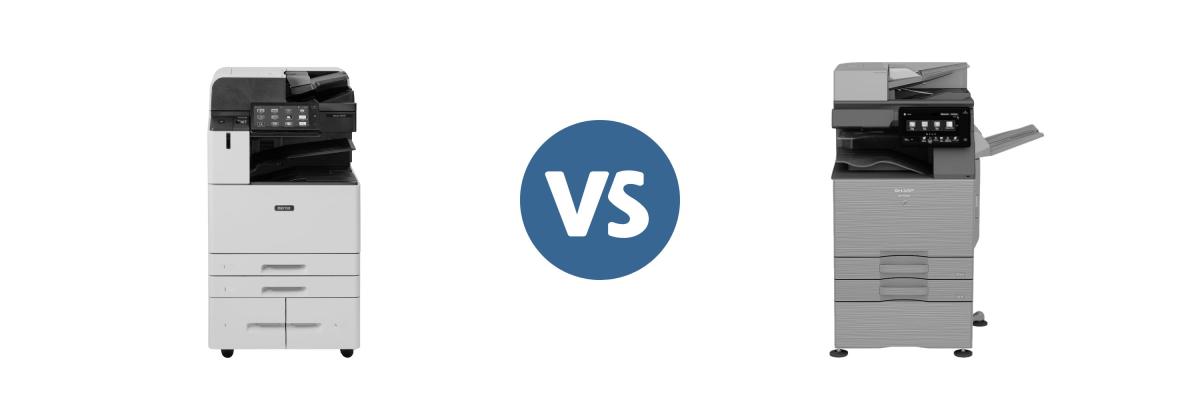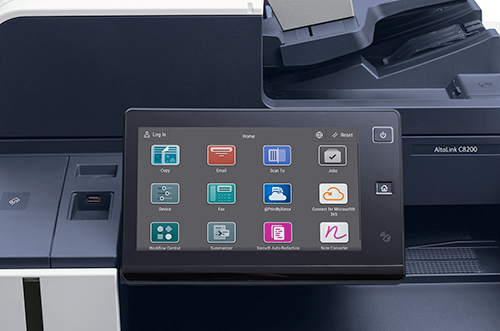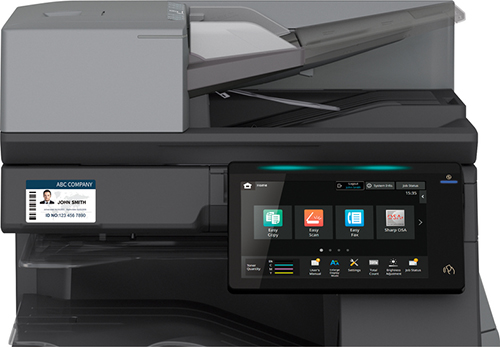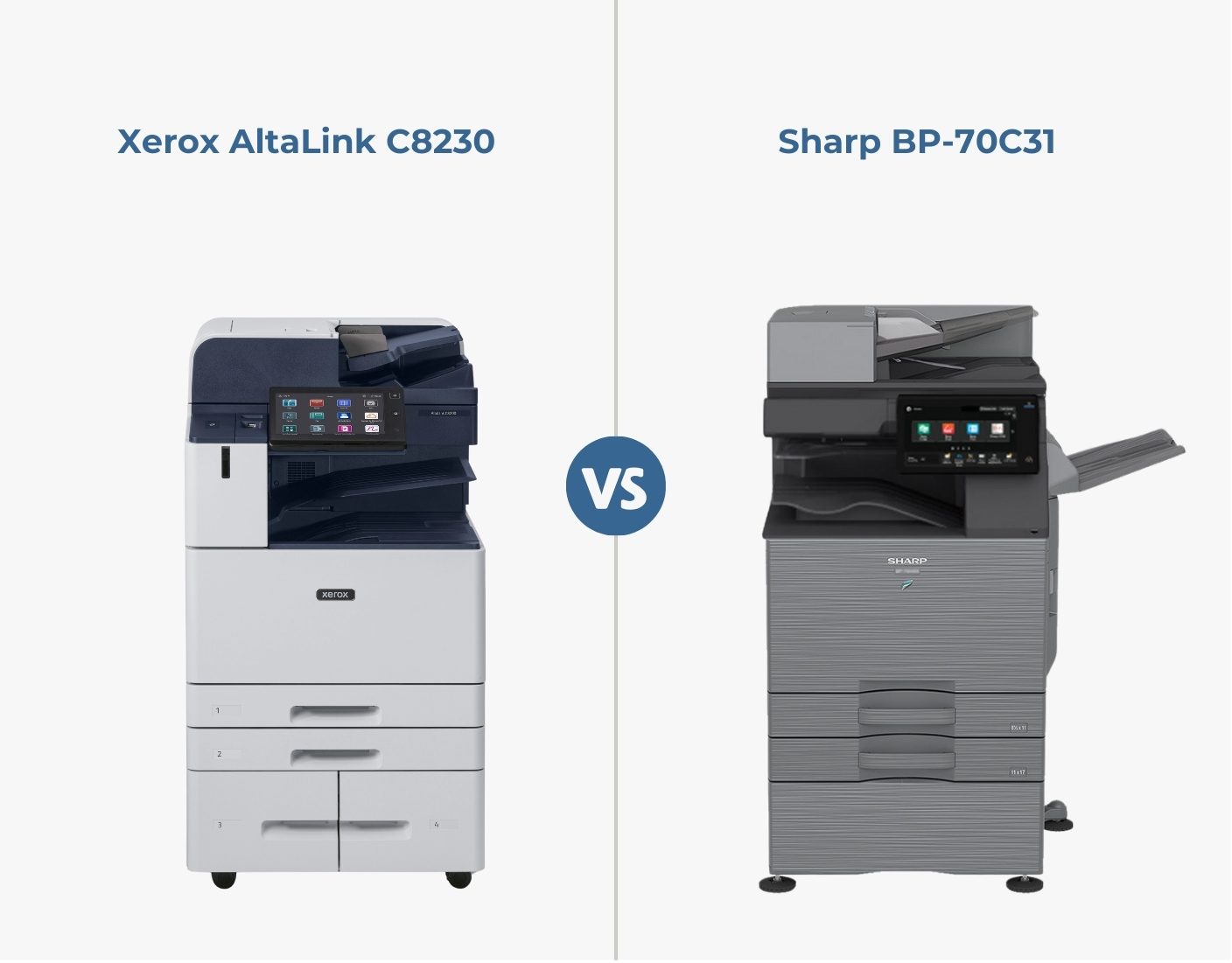
When it comes to office printers and copiers, Xerox and Sharp are two well-known brands offering a variety of solutions. Both have carved out a reputation for reliability, innovation, and strong security features. But how do these two brands stack up against each other?
At Strategic Technology Partners of Texas (STPT), we’ve helped businesses make informed decisions about their office equipment for decades. In this article, we’ll dive into the similarities and differences between Xerox and Sharp to help you decide which brand is the best fit for your business.
Overview: Xerox and Sharp
Xerox
- Founded: 1906, Rochester, NY
- Known For: Revolutionizing office printing with the first xerographic copier.
- Specialties: Multifunction printers, production printers, and advanced software solutions like ConnectKey.
- Strengths: High-volume printing capabilities, extensive app options, and industry-leading security.
Sharp
- Founded: 1912, Tokyo, Japan
- Known For: Diverse electronics, with a strong presence in office technology.
- Specialties: Compact and full-size multifunction printers (MFPs), production printers, and Synappx solutions.
- Strengths: Compact designs for smaller offices, energy efficiency, and robust security through the Sharp Security Suite.
2 Similarities Between Xerox and Sharp
1. Diverse Office Printing Solutions
Both Xerox and Sharp cater to a variety of office needs, from small workgroups to high-performance environments:
Xerox:
- Small, medium, and large workgroup printers.
- High-volume production presses for print-on-demand workflows.
- Examples: VersaLink (small/medium offices), AltaLink (large offices), and Iridesse Production Press (production).
Sharp:
- Compact MFPs for smaller spaces.
- Full-size MFPs for demanding work environments.
- Production Print for on-demand, high-quality performance.
Both brands deliver a range of solutions, making them versatile options for businesses of all sizes.
2. Commitment to Security
Office security is critical, and both brands excel in this area:
Xerox Security:
- Four-point approach to security: Intrusion prevention, data protection, and device detection, + partnerships.
- Collaborate with Trellix to incorporate their whitelisting technology and integrate it with Cisco’s Identity Services Engine for enhanced security.
- Common Criteria-certified security across devices.
Sharp Security Suite:
- Multi-layered security with standard features, a Data Security Kit, and print driver security.
- Advanced tools like Bitdefender antivirus, automatic firmware updates, and end-of-lease data erase.
- Unique features include real-time intrusion detection and BIOS integrity checks.
Both brands offer solid security measures, but Xerox stands out thanks to its partnerships with Trellix and Cisco, adding even more trust to its security solutions.
Additionally, Xerox has a strong security portfolio, especially in protecting workflows and content. This means Xerox can offer reliable protection for both hardware and digital documents, keeping your data safe from start to finish.
As remote work grows, it's crucial to secure printers because they can be gateways for network breaches.
Read the blogs below to learn more about printer security and why it’s a top concern for most businesses:
- 4 Ways to Protect Your Printer from Cyberattacks
- Why Are Older Printers Security Threats and Should I Replace Them?
- 5 Common Printer Security Mistakes (With Solutions)
2 Key Differences Between Xerox and Sharp
1. Printer Apps and Personalization
While both Xerox and Sharp offer touchscreens with customizable menus, their approaches differ:
Xerox AltaLink 8200 Series UI

Sharp BP-70C31 UI

Xerox:
- ConnectKey Technology enables app integration and personalization on VersaLink and AltaLink devices.
- Xerox App Gallery offers a wide selection of apps, including unique options like the Summarizer and Translate and Print.
- Custom app creation through the Personalized Application Builder program.
Sharp:
- Synappx Platform focuses on workflow simplification, collaboration, and IT control.
- Apps are primarily connector-based (e.g., cloud connectors) and developed via the Sharp OSA platform.
- Limited proprietary apps compared to Xerox’s gallery.
Conclusion: If app variety and flexibility are important, Xerox leads the way with a broader
ecosystem.
Should you invest in printer apps? Read our blog on the pros and cons of printer apps to learn more.
2. Managed Print Services
A key difference between Xerox and Sharp lies in the scope and focus of their Managed Print Services (MPS) offerings. Both brands aim to optimize print environments and reduce costs, but their approaches and features differ in a few ways.
Xerox Managed Print Services
- Proactive Monitoring & Security:
Xerox’s MPS includes AI-driven analytics and automated tools for real-time device monitoring, predictive maintenance, and supply management. Security is a top priority, with features like automatic remediation of cyber threats and integration with Trellix and Cisco technologies to ensure compliance with data protection regulations.
- Focus on Digital Transformation:
Xerox takes a holistic approach, combining print and digital workflow optimization. Their Workflow Central Platform automates document management tasks such as translation, summarization, and conversion. Xerox integrates seamlessly with cloud solutions like Microsoft Office 365 and Google Workspace, driving digital transformation across organizations.
- Global Scalability:
Xerox's MPS is built for large, global organizations, supported by Augmented Reality (AR)-powered service delivery for efficient, 24/7 support. It also integrates with third-party tools like ServiceNow for a seamless IT experience.
Sharp Managed Print Services
- Customized Fleet Optimization:
Sharp emphasizes a consultative approach to fleet management. They start with a thorough assessment of the print environment, including device mapping, usage analysis, and cost evaluation. Sharp then removes redundant devices, replaces outdated models, and consolidates contracts to simplify management.
- Simplified Support:
Sharp’s MPS consolidates all printing needs under one vendor, offering a single, predictable cost-per-copy plan. This simplifies budgeting and eliminates the complexity of managing multiple vendors. Proactive fleet monitoring ensures toner arrives just in time and devices maintain high uptime.
- Focus on IT Relief:
By managing the entire print environment, Sharp frees up IT resources to focus on critical projects. They provide end-user training and coordinate with key stakeholders for smooth program rollouts.
Both MPS programs offer valuable features, but the best choice depends on your business size, priorities, and goals.
Which Printer Brand Has the Best Prices?
When comparing two printers, price is often a key factor—but so are features that impact long-term value, like print speed, resolution, and paper capacity. So how do Xerox and Sharp compare?
Let’s look at two similar models: the Xerox AltaLink C8230 and the Sharp BP-70C31, both A3 color multifunction printers designed for medium workgroups.
A Printer Model Comparison

Difference #1: Print Resolution
One key distinction between the Xerox AltaLink C8230 and the Sharp BP-70C31 is their print resolution:
- Xerox provides 1200 x 2400 dpi, making it a better choice for high-quality, detailed printing such as marketing materials or graphics-heavy documents.
- Sharp, while adequate for most office needs, offers 1200 x 1200 dpi for monochrome and 600 x 600 dpi for color, which is slightly less sharp than Xerox’s capabilities.
This difference makes Xerox a better option for industries like marketing, design, publishing, or any business where output quality is critical.
Difference #2: Finishing Options
Both printers offer finishing options, but Xerox provides a more comprehensive suite:
- Xerox AltaLink C8230 includes booklet-making, stapling, saddle stitching, Z-folding, C-folding, and hole-punching capabilities, catering to businesses requiring professional-grade output.
- Sharp BP-70C31, while versatile with options like tri-fold and Z-fold patterns, focuses on simpler finishing needs.
If your business requires custom booklets, pamphlets, or other specialized materials, Xerox’s advanced options stand out.
Which Printer Model Is Better?
Choosing between the Xerox AltaLink C8230 and the Sharp BP-70C31 depends on your specific needs:
- Choose Xerox if:
- High-resolution printing is crucial for your business.
- You need advanced finishing options for professional-grade output.
- Choose Sharp if:
- Budget is a primary concern, and you want a slightly lower upfront cost.
- Your focus is on general office tasks with moderate finishing requirements.
Both printers are excellent long-term investments, offering reliability and robust features. However, total cost of ownership—including maintenance, supplies, and usage—should also play a role in your decision. For more guidance on choosing the right printer, check out our comprehensive Guide to Buying or Leasing a Printer!
Which Brand Should You Choose?
The answer depends on your needs:
- Choose Xerox if you:
- Need advanced app functionality and robust MPS tools.
- Value extensive finishing options and high-volume capabilities.
- Choose Sharp if you:
- Prioritize compact designs and energy efficiency for smaller spaces.
- Want solid security features with budget-friendly options.
Find the Right Printer
At STPT, we’re here to help you navigate these choices. Whether it’s Xerox, Sharp, or another brand, our team is dedicated to finding the perfect fit for your business.
Interested in how Xerox printers can fit your needs? Explore our range of printers using our product configurator and see what sets them apart.
Not sure which printer is right for your business? Contact us for a consultation, and we’ll help you weigh your options.
Also, check out our other comparison blogs:

